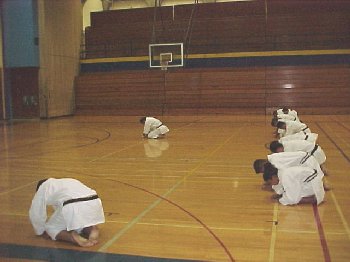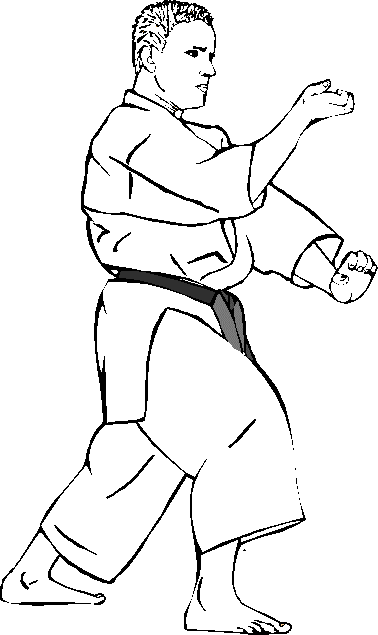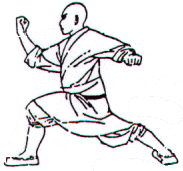|



| |
Karate-Do
Karate-Do loosely
translated means "the way of the empty hands."
Its origin can be traced back thousands of years to China, and later
to Okinawa. In the early twentieth century, a Karate master by the
name of Gichin Funakoshi introduced Okinawa Karate to Japan,
and subsequently to
the world.
Benefits of Karate-Do
Traditional Karate-Do is an
effective means of self-defense.
It is also a holistic activity which strengthens all parts of the
body, increasing
cardio-vascular fitness as well as balance and
agility. It fosters the traits of courage, courtesy, integrity,
humility and self control, i.e. it builds character. To the sport
conscious Karate-ka, Karate skills can be tested in regularly
organized competitions.

Karate-do History
Most Western students of
Asian martial arts, if they have done any research on the subject at all, will
surely have come across references to Bodhidharma. He is known as
"Daruma" in Japan and as often as not, this Indian Buddhist monk is
cited as the prime source for all martial arts styles or at the vary least,
for any style which traces its roots back to the fabled Shaolin Temple.
However, the question of his contributions to the martial arts and to Zen
Buddhism and even of his very existence has been a matter of controversy among
historians and martial arts scholars for many years (Spiessbach,1992).
As legend has it, the evolution of karate began over a thousand years ago,
possibly as early as the fifth century BC when Bodhidharma arrived in Shaolin-matsu
(small forest temple), China from India and taught Zen Buddhism. He also
introduced a systematized set of exercises designed to strengthen the mind and
body, exercises which allegedly marked the beginning of the Shaolin style of
temple boxing. Bodhidharma's teachings later became the basis for the majority
of Chinese martial arts. In truth, the origins of karate appear to be somewhat
obscure and little is known about the early development of karate until it
appeared in Okinawa.
Okinawa is a small island of the group that comprises modern day Japan.
It is the main island in the chain of Ryuku Islands which spans from Japan to
Taiwan. Surrounded by coral, Okinawa is approximately 10 km (6 mi) wide and
only about 110 km (less than 70 mi) long. It is situated 740 km (400 nautical
mi) east of mainland China, 550 km (300 nautical miles) south of mainland
Japan and an equal distance north of Taiwan. Being at the crossroads of major
trading routes, its significance as a "resting spot" was first
discovered by the Japanese. It later developed as a trade center for
southeastern Asia, trading with Japan, China, Indo China, Thailand, Malaysia,
Borneo and the Philippines.
In its earliest stages, the martial art known as "karate" was
an indigenous form of closed fist fighting which was developed in Okinawa and
called Te, or 'hand'. Weapons bans, imposed on the Okinawan's at various
points in their history, encouraged the refinement of empty-hand techniques
and, for this reason, was trained in secret until modern times. Further
refinement came with the influence of other martial arts brought by nobles and
trade merchants to the island.
Te continued to develop over the years, primarily in three Okinawan cities:
Shuri, Naha and Tomari. Each of these towns was a center to a different sect
of society: kings and nobles, merchants and business people, and farmers and
fishermen, respectively. For this reason, different forms of self-defense
developed within each city and subsequently became known as Shuri-te, Naha-te
and Tomari-te. Collectively they were called Okinawa-Te or Tode, 'Chinese
hand'. Gradually, karate was divided into two main groups: Shorin-ryu which
developed around Shuri and Tomari and Shorei-ryu which came from the Naha
area. "It is important to note, however, that the towns of Shuri, Tomari,
Naha are only a few miles apart, and that the differences between their arts
were essentially ones of emphasis, not of kind. Beneath these surface
differences, both the methods and aims of all Okinawan karate are one in the
same" (Howard, 1991). Gichin Funakoshi goes further to suggest that these
two styles were developed based on different physical requirements Funakoshi,
1935). Shorin-ryu was quick and linear with natural breathing while Shorei-ryu
emphasized steady, rooted movements with breathing in synchrony with each
movement. Interestingly, this concept of two basic styles also exist in
kung-fu with a similar division of characteristics (Wong, 1978).
|

